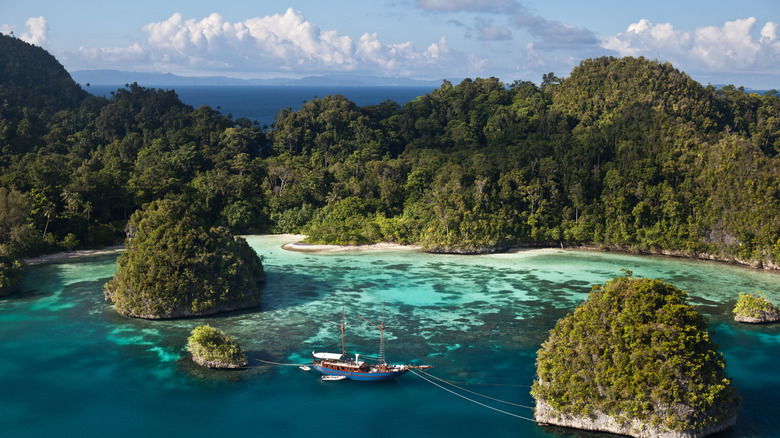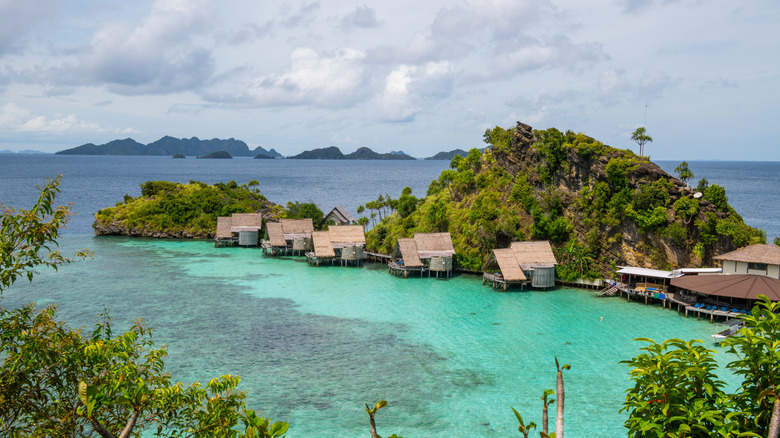One Of The World's Top Snorkeling Destinations Dazzles With Majestic Mantas And Technicolor Reefs
All around the world, stunning coral reef systems are hiding just below the ocean waves. Breathtaking destinations like this pristine snorkeling spot in Oahu are perfect for diving into an underwater adventure. Far off at the juncture of the Pacific and Indian Oceans, within a vast archipelago of 1,500 islands, a whole new world of undersea exploration awaits. Known as Raja Ampat, it's part of Indonesia in Southeast Asia, and contains tropical atolls and glistening sandbanks to tickle a seasoned snorkeler's fancy.
The iconic vista of Raja Ampat captures the clusters of forested islands rising from turquoise waters, but the real treasures are what lie beneath. Unlike many other reefs, Raja Ampat is a protected marine reserve, meaning the coral here is in wonderfully healthy condition, with excellent aquatic life, impressive undersea ridges, thick mangroves, and reef formations. Better yet, an abundance of manta ray cleaning stations and feeding zones means snorkelers can share the waves with these majestic creatures as they glide overhead. Keep your eyes peeled and you might also glimpse dolphin pods, shimmering schools of barracuda, green turtles weaving between the vivid coral pinnacles, and colorful fish hiding between mangrove roots.
If you're a certified diver, you could also plunge into the over 20 dive sites reaching depths of more than 60 feet, while snorkelers can enjoy the colorful marine life from the shallows along the shoreline. For those who have never snorkeled before but still want to explore the coral reefs, make sure to read these tips about mistakes to avoid when snorkeling for the first time. There are many islands scattered across Raja Ampat, so choosing which to visit for some unforgettable snorkeling may seem daunting, but there are several well-known hotspots that shouldn't be missed.
Exploring the different islands in Raja Ampat
Meaning "Four Kings" in the Indonesian language, Raja Ampat is comprised of four main islands (Waigeo, Misool, Batanta, and Salawati) surrounded by clusters of smaller cays and atolls. The largest island, Waigeo, is rather difficult for travelers to reach, but the reefs here are spectacular. The Alyui Bay on the western shores of Waigeo boasts scenic landscapes of lush jungles and crystal clear waters. Here, you'll catch sight of dolphins searching for food amidst the corals, and it's also a great opportunity to try nighttime snorkeling. The shallow waters are adequately illuminated by bright moonlight, revealing nocturnal creatures like cuttlefish, squid, and seahorses.
Another great spot is Misool, the southernmost island of the archipelago, home to the Misool Marine Reserve, where, thanks to the strictly regulated protections, the coral reefs are healthily blossoming. Soft coral and anemone line the rugged seabed in vibrant variety, and you'll see plenty of manta rays too, getting cleaned by smaller fish.
The Dampier Strait between the island of Waigeo and Batanta also offers some excellent snorkeling opportunities. Coral reefs here reach dramatic pinnacles and ridges, while thick mangroves add interesting underwater scenery. The straits are also a migration highway for whales and dolphins, who snack in the nutrient-rich waters as they journey. The Dampier Strait is also much easier to access than some other locations, which might be a factor when planning your trip. You could also book an expedition through The Oceanic Society, as they offer a variety of snorkel and dive trips to Raja Ampat, which includes whale-spotting from on deck while sailing to different snorkeling spots.
Getting to Raja Ampat and where to stay
While getting to the islands of Raja Ampat may be a rather arduous journey, the stunning marine life and snorkeling spots are worth it. The first step will be to book a flight to Indonesia's capital city, Jakarta. From there, you'll need to reach Sorong, the port city in West Papua where ferries depart for the Raja Ampat archipelago.
To reach the islands around Waigeo, the best option is to book a liveaboard tour, which will take care of all the necessary trip details and travel logistics like boat charters, travel between islands, and safety gear. Local expert guides can also help with the language barrier and ensure the snorkeling spots you visit meet the right depth for good snorkeling. Great options for booking a liveaboard expedition include The Oceanic Society or Wilderness Travel. Some tours will include transport from Jakarta to Sorong while others don't, so make sure to check first.
For snorkeling in the Dampier Strait, there are plenty of homestays and resorts along the coastlines that can arrange snorkeling trips for you. Try the Kri Eco Resort on Kri Island south of Waigeo, with rustic thatched cottages right over the azure waters of the Dampier Strait. Guided snorkel tours can be arranged directly, and the resort even has a spa to unwind after a busy day of reef exploration. Another option is the Papua Explorers Dive Resort, situated along the south coast of Waigeo, which can be accessed by regular boat transfers from Sorong. Overwater bungalows offer a tranquil atmosphere for relaxation, and you can book daily snorkeling excursions directly with the resort. If you want to explore even more snorkel sites around Indonesia, consider visiting Satonda, a ring-shaped snorkeling paradise.


